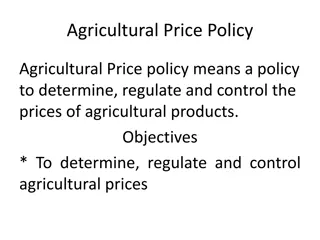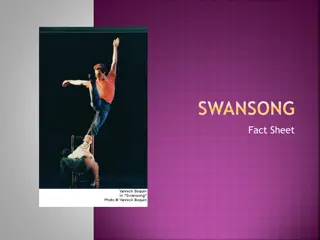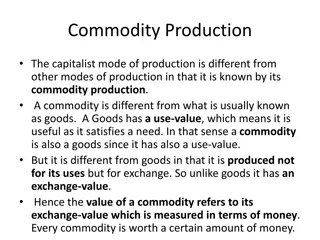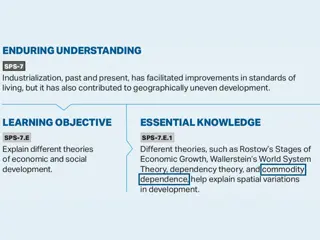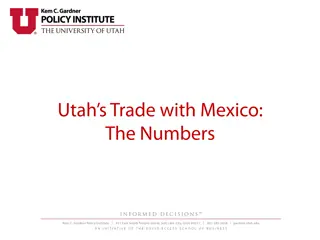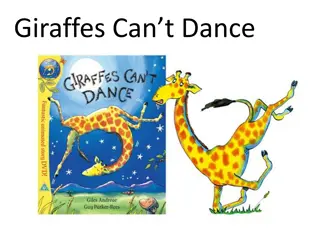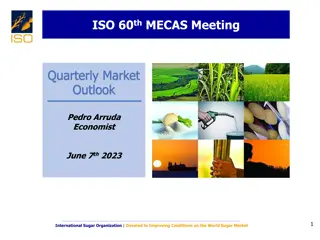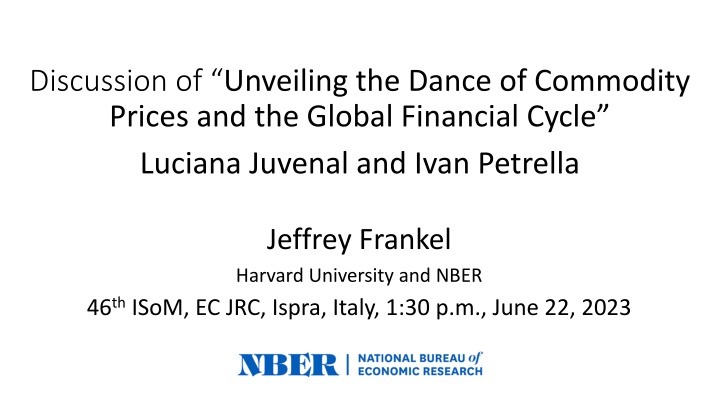
Unveiling the Dance of Commodity Prices
This presentation discusses the relationship between commodity prices, global financial cycles, and their impact on emerging market and developing economies. It explores the role of commodity export revenue as collateral for loans and examines the effects of export price shifts on business cycles, capital flows, and debt financing costs within these economies.
Download Presentation

Please find below an Image/Link to download the presentation.
The content on the website is provided AS IS for your information and personal use only. It may not be sold, licensed, or shared on other websites without obtaining consent from the author. If you encounter any issues during the download, it is possible that the publisher has removed the file from their server.
You are allowed to download the files provided on this website for personal or commercial use, subject to the condition that they are used lawfully. All files are the property of their respective owners.
The content on the website is provided AS IS for your information and personal use only. It may not be sold, licensed, or shared on other websites without obtaining consent from the author.
E N D
Presentation Transcript
Discussion of Unveiling the Dance of Commodity Prices and the Global Financial Cycle Luciana Juvenal and Ivan Petrella Jeffrey Frankel Harvard University and NBER 46th ISoM, EC JRC, Ispra, Italy, 1:30 p.m., June 22, 2023
An episode that could motivate the paper: 1982 international debt crisis (though Juvenal-Petrella sample is 1990-2019) A perfect storm ? Four causal factors: 1. Increase in US & global real interest rates 1980-82 => fall in investor willingness to lend to EMDEs, reflected, e.g., in spreads 2. Global recession 1981-82 => loss of export markets 3. Appreciation of $ => adverse balance sheet effect in $-indebted countries 4. Post-1980 fall in real global price of oil & other commodities. All 4 factors were exogenous from the viewpoint of most individual EMDEs, but causally related at the global level: Volcker tightening => US real interest rates => global recession => $ appreciation } Commodity prices =>
Three puzzles can be explained by treating commodity export revenue as collateral for loans 1.Puzzles a.Lucas (1990) Paradox: capital flows uphill b.Capital flows are procyclical E.g., Reinhart & Reinhart (2009) When it rains it pours c.Dutch Disease/Natural Resource Curse Manzano & Rigobon (2008) channel: High prices for export commodity => capital inflow => over-indebtedness. 2.Collateral explanation: with imperfect creditworthiness, global investors lend to countries that can offer collateral, which export revenue provides.
Rises in export prices correlated with declines in BAA spreads Juvenal & Petrella Figure 1(f) Supports the notion that commodity export revenue serves as collateral for borrowing.
The authors summary of the literature Rey (2013) emphasizes common determinants driving the coordinated ebbs and flows of capital, asset price fluctuations, and crises worldwide phenomena collectively known as the Global Financial Cycle .traditionally linked to shifts in U.S monetary policy and changes in risk-aversion and uncertainty However, more recently, Davis et al. (2021) and Agrippino & Rey (2021) underscore commodity prices as a potential engine of the GFC. (p.1)
The authors summary of their findings Our findings substantiate the significant impact of export price shifts on business cycles, capital flows, and debt financing costs within EMDEs, underlining their susceptibility to commodity price fluctuations. We show that these fluctuations do not purely reflect idiosyncratic shocks in commodity markets, instead evidencing linkage to key determinants of the global financial cycle, notably shifts in U.S. monetary policy and changes in global risk appetite. (p.29)
Slide #1 from Rabah Arezki (CNRS), the originally scheduled discussant for this session Summary: It is a great paper. It is competently executed with up-to-date techniques. Suggestion: Reorder the structure of the paper Put the 2nd block on the indirect effect of commodity export shocks through GFC 1st . Why? That is the main/original result of the paper. Avoid a rather cumbersome demonstration of the originality of the paper which, as it stands now, starts with well-established results linking commodity export price shocks and the business cycle of EMDEs
Slide # 2 from Rabah Arezki Lack of theory/conceptual discussion linking GFC & commodity prices Suggestion: Further the interpretation of the main result of the paper by invoking the existing literature on role of interest rates (Frankel 2008 & 2013), speculation & other financial drivers of commodities and perhaps also on (policy) uncertainty. Why? As it stands, the authors implicitly assume commodities are a class of assets alongside stocks & bonds and hence subjected to GFC but not much more Deepening interpretation will help exploit the granularity of the results linked to the 2 sources of shocks driving GFC and the composition of capital flows (FDI vs. portfolio flows). What of the sectoral dimensions of extractive activities linked to commodity? Hypothesis: Higher commodity prices=>higher FDI/portfolio inv. in the sector?
Slide #3 from Rabah Arezki Suggestion: More systematic decomposition of commodity price fluctuations Use the decomposition of Kilian (2009) instead of the current identification strategy using a list of exogenous events to isolate the idiosyncratic component driving commodity prices. Why? Kilian proposes a more systematic decomposition of oil price shocks disentangling demand and supply components with the residual components interpretated as driven by speculation. That latter component could usefully link more directly to the endogenous response of commodity prices to GFC.
Slide #4 from Rabah Arezki Precious metals versus other commodities Suggestion: Explore the differentiated effect of the GFC on capital flows to EMDEs depending on whether the commodities are precious metals or not. Why? Precious metals like gold are typically seen as hedges and safe havens. The behavior of investors vis- -vis precious metals is expected to be different from other commodities such as agricultural commodities. South Africa is a good example of an economy specializing in gold exports, subject to exchange rate volatility, and with the composition of capital flows skewed to portfolio flows. Is this the result of investors willing to get exposure to gold through portfolio investment? How different does South Africa fare in the GFC compared to EMDEs not specializing in precious metals?
Slide #5 from Rabah Arezki Mozambique and export quantity weights Suggestion: Use constant weights for export exposure to commodity prices instead of time varying weight. Why? Quantities exported are endogenous to commodity price fluctuations. Time-varying weights may add noise to the identification of the effect of commodity prices on the business cycle of EMDEs. Another challenge (not addressed by fixed weights): EMDEs such as Mozambique have discovered giant oil field and major minerals deposits. The anticipation effect drives the current account (Arezki et al. QJE 2017) and EMBI spreads (Esquivel, 2023).
Slide #6 from Rabah Arezki Heterogeneity in institutional arrangements Suggestion: Explore the role of institutional arrangements in mediating the effect of commodity price shocks on the business cycle of EMDEs. What institutional arrangements? Fiscal discipline. Many countries have graduated from fiscal procyclicality.1/ Fiscal rules may intermediate the commodity price effect on the business cycle of EMDEs. 2/ Exchange rate regime & capital account restrictions may explain the more muted response of capital flows to commodity prices & GFC. 1/ Frankel, Vegh & Vuletin (2013) 2/ Pieschac n (2012).
I have two questions 1. The imperfect storm : When Russia invaded Ukraine in 2022 (an idiosyncratic shock), causing sharp increases in oil & grain prices, why was that bad for EMDEs, especially in Africa ? 2. Arezki s question: Why, exactly, do tight global financial conditions have a negative effect on commodity prices?
3 theories of the interest rates role in commodity markets Non-renewable resources: Interest rate determines whether to leave oil & minerals in the ground. Hotelling (1931) Competitive storage model Gustafson (1958), Muth (1961), Samuelson (1971), Deaton & Laroque (1992, 96). My preferred version: Overshooting model of commodity prices Frankel (1986, 2006, 2014).
The overshooting model of commodity prices 1st assumption: regressive expectations E[ q] = - (q- ? ) E[ s - p] = - (q- ? ) (1) (2) where q s p the log of the real commodity price ? the long-run equilibrium log real commodity price s log of spot commodity price p log of overall price level. This specification of expectations can be shown rational, in a model of sticky prices and the right value of .
E (s) = - (q- ? ) + E(p). (2) Combine (2) & (3) + 2nd assumption: speculative arbitrage E( s)+ c = i, where: i interest rate (3) c cy sc rp cy convenience yield sc storage costs rp risk premium => - (q- ? ) + E( p) + c = i => q = ? - (1/ ) (i - E( p) c) (4) . Result: q moves inversely to the real interest rate, when controlling for ? and c . Does it work?
The overshooting model The overshooting model Regression of real commodity price indices, q, against real interest rate (1950-2012) Table 1 Dependent variable: log of commodity price index, deflated by US CPI Goldman Sachs Index CRB index -0.041*** (0.007) 0.900*** (0.017) 739 0.04 Dow Jones Index -0.034*** (0.006) 0.066*** (0.016) 739 0.04 *** p<0.01 Moody s index -0.071** -0.075*** (0.005) 2.533*** 0.732*** (0.011) 739 0.25 (Standard errors in parentheses.) VARIABLES Real interest rate (0.007) Constant (0.018) 513 0.18 Observations R2 Frankel, 2014, "Effects of Speculation and Interest Rates in a Carry Trade Model of Commodity Prices, JIMF.
Discussion of Unveiling the Dance of Commodity Prices and the Global Financial Cycle Luciana Juvenal and Ivan Petrella
Appendix: With controls for convenience yield, storage costs, & risk A panel across all 11 commodities (1950-2012: 492 annual observations) Dependent variable: real commodity prices (log) (6) -0.03** (0.01) Real interest rate Global Business Cycle (HP-Filtered World GDP) 7.22*** (1.08) Log Inventories -0.14*** (0.02) -0.003*** (0.001) 1.92*** (0.51) -0.02*** Future-Spot Spread, % Volatility => Commodity prices , because of higher demand for inventories Volatility: Standard deviation of log spot price of past year Linear Trend (0.00) 0.32 Constant Frankel, 2014, JIMF, Table 3a. (0.23) 0.49 R2
With controls for convenience yield, storage costs, & risk First differences to guard against non-stationarity (1950-2012) Dependent variable: real commodity prices (log) (7) -0.029** Real interest rate (0.012) Forecast 2-yr.US GDP growth (Consensus Forecasts monthly) 11.365*** (2.178) 0.002*** (0.000) -0.008 (0.056) -0.002*** (0.000) 0.068 Quadratic trend Log Inventories Future-Spot Spread, % of log spot price over past year Volatility: Std.dev. (0.208) Linear Trend -0.024*** (0.005) Constant -0.271*** (0.071) Observations R2 216 0.27 Frankel, 2014, JIMF. Table 3b






